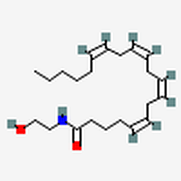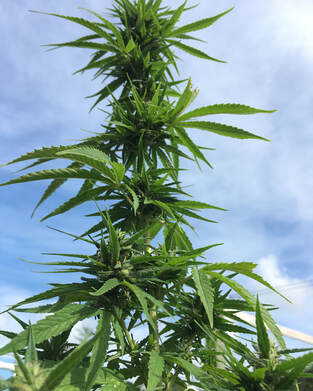 If you thought the last blog on CBD and THC blew your mind, hold on to your hats (and be sure to read it if you haven't to help here) because we're just getting started! Research is changing what we understand as scientific fact at dramatic rates and we "common folk" don't always get the update. In fact, many medical professionals aren't fully up to speed either. For example, what I learned today while exploring more on CBD. Most of us can at least recall that we learned about our body's 11 main systems (yeah, more time under the thinking cap) at some point in school: circulatory, digestive, endocrine, integumentary (skin, nails, hair), lymphatic, muscular, nervous, reproductive, respiratory, skeletal and urinary. But, how many of us are aware of the fact that there is a 12th system, the endocannabinoid system (ECS)? Yeah, pause here for a moment....you'll need it. The ECS was discovered in the 1990s by a Dr. L.A. Matsuda while exploring how THC effects the body. What he discovered was a cannabinoid receptor (CB-1) network in both the central nervous system (spine and brain) and peripheral nervous system (the system outside of the brain and spinal cord which includes the immune system). Since then, other receptors (CB-2) have been located in numerous other systems like the immune system, as well as the digestive tract and throughout many of our organs. A receptor works like a lock and key. The lock is the receptor, the key is a chemical compound that fits the lock, in this case the keys are called endocannabinoids. Within our bodies we have receptors for all kinds of chemicals we make - 2 you've probably heard of are serotonin and dopamine. The chemicals fit into their specific receptors to turn things on and off. Just like a house key won't fit the car and the car key won't unlock a storage unit, each specific chemical matches to a specific receptor and they stimulate everything from hunger to how our DNA responds to toxins. What makes this new system so fascinating is that if we have receptors for cannabinoids, we must then make our own cannabinoid-like chemcials (we do) that plug into those receptors! Stay with me here because what scientists also learned was that our cannabinoids (called endocannabinoids) play a key role in how our 11 other systems function by fine-tuning them to ensure our bodies stay in balance (homeostasis). In fact, cannabinoids impact everything from appetite, inflammation, memory, mood, pain and reproduction to sleep and the research is just beginning. These internal chemicals (endocannabinoids) modulate the regulation of homeostasis (balance) across all our major body systems to ensure they collaborate/communicate. Basically, they help all of our individual systems stay balanced and, in doing so, help our bodies respond at their best in protecting us, for example, against colds, the flu and other disease. Let me state this again: this single system helps to regulate and balance all of the other major systems of the body. (Take the "aha moment" here if you need it). Why haven't we heard more about this until recently (today)? Because despite being used for millennia by healers and early doctors, interest and use of hemp/CBD waned with the onset of opioid use. While traditional medicine accounted for the effects of cannabis on the body (it's role in the intercommunication among our self-regulating processes such as temperature control, pain control, appetite), etc., this knowledge has gotten lost in a sea of modern medicine...until recently. In fact, a 2013 study revealed only 13% of medical schools were including the ECS in their curriculum. As interest in, and laws about, CBD continue to evolve, more of us are becoming aware of the role cannabinoids play in our overall health and well-being. How does all this translate to everyday living? Well, the ECS can be knocked out of balance by things like a diet high in sugar and unhealthy fats which can leave us hungry and cascade into the other systems. The ECS also gets tossed into a tizzy during times of stress when it's overstimulated and causes imbalances among the other 11 systems. So, what can any of us do to keep our ECS running smoothly? Balance intake of Omega 3 & 6 fatty acids by adding fish oil, flax and hemp oil/seeds into a regular healthy diet as they turned into endocannabinoids (the keys seeking our CB-1 and CB-2 receptors/locks) Reduce intake of sugar and unhealthy fats Exercise regularly as it releases endocannabinoids that help to regulate all our systems Add naturally occurring CBD oil as part of a healthy lifestyle since it enhances the body's ability to produce endocannabinoids in the ECS Share factual information about CBD with others, including medical professionals Research in this field continues to surprise scientists who are discovering that ECS receptors are prevalent in all animals and that endocannabiniod receptors in humans are more prevalent than those for serotonin and dopamine. One day, scientists hope to be able to re-balance/restore the ECS system to support our body's natural ability to address cancer, neurodegenerative disease, arthritis and promote good health. There is also research exploring "ECS deficiency syndrome" as a potential root cause for migraines, fibromyalgia, IBS and more. Only time will tell. What we do know is that natural cannabinoids (like those found in a high quality CBD oil) have been shown to provide therapeutic effects and have been used for thousands of years for everything from headaches, arthritis, depression and nausea to epilepsy (and more). Have questions about what you just read? Good! You should. Feel free to drop a line to [email protected] and follow this blog because we're just getting started! Image: Anandamide (a endocannabinoid found in the human body). Source: PubChem.
0 Comments
 Cannabis...As you may have seen if you follow me on Facebook or Instagram, I recently started sharing my introduction to CBD oil. Clearly, I more than dapple in what many consider “alternative therapies” (essential oils, supplements, herbs, yoga, meditation/prayer, Reiki), so this has actually been a longtime coming. My concerns – as it is with everything I put in, on or around my body – are whether or not any product contains toxins or compounds harmful to me and the environment, of course. Also, whether a product comes from a reliable, reputable source. So, I waited. And, waited again. When I finally discovered some products held to the highest standards in the industry, I did a bit more research and decided to give the CBD oil items a try. Like most of us, I’ve heard all the slang. I thought I knew what hemp, marijuana, CBD and THC were. But, a hit of the google bar first left me confused and then, after deeper digging, clarified. Truthfully, there’s misinformation out there so put on your “thinking cap” for a condensed overview of terms like Cannabis, hemp and marijuana, plus an intro to CBD and THC. A member of the plant Family Cannabaceae, the genus Cannabis is actually comprised of three species: 1. Cannabis sativa (C. sativa - what we’re exploring here) 2. Cannabis indica (C. indica) 3. Cannabis ruderalis (C. ruderalis) I told you to put your thinking caps on! For those who learn visually – largest to smallest: Cannabaceae (family) Cannabis (genus) C. sativa C. inidica C. ruderalis (species) Both what we call hemp and marijuana are really C. sativa. Hemp is a term used for Cannabis plants containing 0.3% or less of THC by dry weight and is sometimes called industrial hemp because, as one of the fastest growing plants on the planet, it can be developed into clothing, textiles, biodegradable plastics, biofuel, food, animal feed, paint, insulation and paper. Thus, it’s used industrially. Technically, it is not another strain of Cannabis, just C. sativa that does not produce a psychotropic effect. Interestingly, archeologists date the first spun hemp fibers to some 10,000 years ago! The term marijuana actually has racist origins* and is slang used to classify varieties of Cannabis that contain more than 0.3% THC by dry weight. These plants/products can induce what we call a “high”. *When more than a million Mexican immigrants migrated to the US between 1910 and 1920 to flee Mexican Revolution, anti-Mexican sentiments took hold and the word “’marijuana’ arose as a negative correlation of its use by Mexican immigrants.” CDBOrigin. Because they are "varieties" of the same Cannabis plant species, marijuana and hemp are similar and can look alike which has led to confusion, laws, arrests, seizing of plants, fear, hype, etc. What really differentiates hemp from marijuana are the levels of chemical compounds in the plants. While both plants can produce significant quantities of a compound known as CBD, they contain extremely different amounts of the compound THC. What does this mean? It means that hemp, at 0.3% or less THC, does not produce a high whereas marijuana, which can contain up to 30% THC, can. For clarification, CBD is short for cannabidiol and is found in Cannabis sativa as one of about 113 identified cannabinoids. It accounts for up to 40% of the plant’s extract. Tetrahydrocannabinol, or THC, is also one of these 100+ cannabinoids and was discovered to be the compound producing the psychotropic effects (euphoria/high) in marijuana. I know, take a breath, dab on some CBD oil…it’ll be okay. And, what does ALL that mean? It means we are NOT talking about products containing significant amounts of THC, but rather products that contain therapeutic levels of cannabidiol (CBD) and are being used for purposes related to health and wellbeing…all without the buzz. Stay-tuned to Insta (NourishedPath) and Facebook (BlossomWithOils) for my check-ins on the CBD products I’ve started using and the next blog post about our friends in the Cannabis family. For more information on CBD oil, full spectrum hemp oils and #PalemttoHempology products, or the #CharlesronHempCompany, please email [email protected]. Image: Charleston Hemp Company. |
author
I'm Mary Ann. I am a storyteller using skills, interests, education and experience to help others. Together, we'll explore your story and write a new ending for your journey along the nourished path. Categories
All
archives
June 2024
|

 RSS Feed
RSS Feed